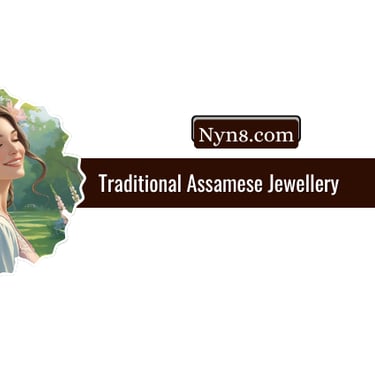Traditional Assamese Jewellery
Kashturi Gogoi


Traditional Assamese jewellery is more than just adornment—it is a living testament to Assam's rich cultural heritage, artistic excellence, and deep connection with nature. Handcrafted by skilled artisans, these exquisite pieces reflect the region's flora, fauna, and daily life through intricate yet minimalist designs. Primarily made of "Kesha Xoon" (raw gold) or silver with gold overlay, Assamese jewellery is cherished for its elegance, symbolism, and craftsmanship passed down through generations.
The Essence of Assamese Jewellery
1. Nature-Inspired Craftsmanship
Assamese jewellery draws inspiration from the region's lush landscapes, featuring motifs such as:
Birds (like pigeons in Lokaparo earrings)
Floral patterns (vines, leaves, and blossoms in Bana necklaces)
Musical instruments (such as the Dhol Biri, shaped like a drum)
Everyday objects (like the Japi, inspired by the traditional conical hat)
2. Materials & Techniques
Gold ("Kesha Xoon"): The primary metal, often used in its raw, unrefined form for an organic look.
Silver with Gold Overlay: Some pieces combine silver with a thin gold coating for affordability without compromising beauty.
Gemstones: Rubies, moonstones, emeralds, and garnets add vibrant contrast to gold and silver.
Handmade Artistry: Each piece is meticulously crafted by Sonari artisans, preserving centuries-old techniques.
Popular ornaments:
Jon Biri: Crescent moon-shaped pendant.
Dhol Biri: Shaped like a drum.
Lokaparo: Earrings shaped as two pigeons back to back.
Gamkharu: A broad bangle made of gold or silver, worn during weddings and festivals.
Doog Doogi: Heart-shaped pendant, light and easy to wear.
Keru: Crescent-shaped earrings.
Thuriya: Round-shaped earrings of simple design.
Bana: Necklaces resembling vine leaves and flowers.
Japi: Cone-shaped cap-inspired necklace with occasional ruby adornments
Cultural Significance & Occasions
Assamese jewellery is deeply intertwined with the state’s traditions:
Weddings: Brides wear Gamkharu bangles, Lokaparo earrings, and elaborate necklaces.
Bihu Festival: Women adorn themselves with Jon Biri and Doog Doogi to celebrate harvest.
Cultural Ceremonies: Jewellery symbolizes heritage, passed down as family heirlooms.
Regional Variations
Upper Assam: More gemstone-studded designs, reflecting royal influences.
Lower Assam: Focus on intricate gold work with minimal stones, showcasing craftsmanship.
Preserving the Legacy
Despite modernization, traditional Assamese jewellery remains relevant due to:
Artisan Communities: The Sonari craftsmen continue age-old techniques.
Certified Stores: Authentic pieces are available in Guwahati and across Assam.
Cultural Revival: Increased appreciation for handmade, sustainable jewellery.
Conclusion: A Symbol of Assamese Identity
Traditional Assamese jewellery is not merely decorative—it tells stories of nature, love, and heritage. From the delicate Lokaparo to the bold Gamkharu, each piece embodies Assam’s artistic soul. Whether worn at weddings, festivals, or daily life, these ornaments keep the state’s cultural legacy alive.